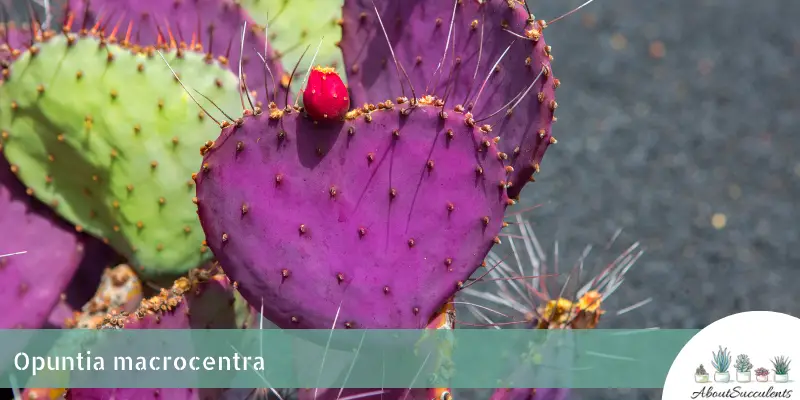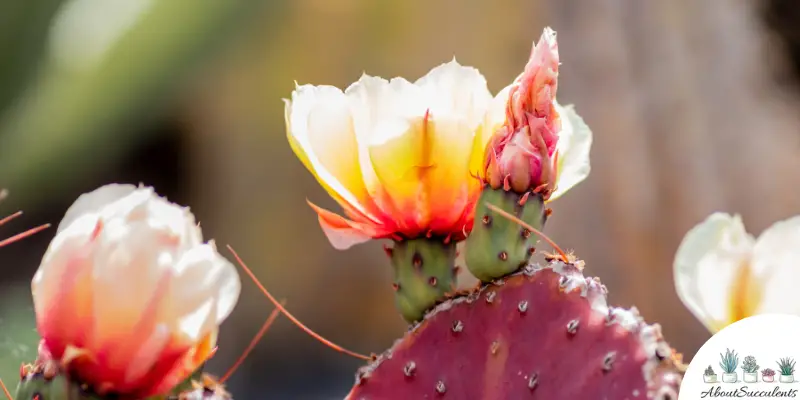
Opuntia macrocentra is a captivating cactus that will easily stand out and brighten your outdoor garden. Before it grows tall, this ground-hugging shrub will first spread out wide and adorn your succulent display with its alluring prickly, green pads that have purple stems.
The word “macrocentra” means long spines and these are very visible on the pads that change color from green to purple when given proper sunlight. In wintertime, the entire plant might turn completely purple.
Opuntia macrocentra goes by a variety of aliases such as “Purple Prickly Pear”, “Long-spined Prickly Pear”, and “Black-spined Prickly Pear”. The spines that sit atop pads with red-colored margins are what distinguish macrocentra from similar species.
When fully matured, Purple Prickly Pear can reach a height of 1.9-feet (60cm) to 3.9-feet (120cm) and spread out as far as 9-feet (3m).
Long-spined Prickly Pear will produce yellow-colored flowers in the springtime. These flowers are small; 1.96-inches (5 cm) to 3.93-inches (10cm) long with a width of 2.36-inches (6cm) to 2.75-inches (7cm).
Unlike other species of Opuntia, macrocentra’s yellow flowers will have a reddish throat that remains unopened. Unfortunately, the flowers will only last for a day. Purple Prickly Pear will bloom in the mid-afternoon and close up at night.
Opuntia macrocentra is native to Northwestern Mexico and the lower Southwestern United States. It’s a member of the Cactaceae family.
General Information
Also known as: Purple Prickly Pear, Long-spined Prickly Pear, and Black-spined Prickly Pear.
Plant Family: Cactaceae
Origin: Northwestern Mexico and the lower Southwestern United States
Height: 1.9-feet (60cm) to 3.9-feet (120cm)
Exposure: Up to 6 hours per day; full to partial sunlight. If indoors, you can use a Grow Light.
Water Needs: Drought-tolerant; use the “Soak and Dry” method for watering
Soil Type: Cactus soil or 2 parts potting soil mixed with 1 part perlite, pumice, coarse sand, and lava rock to speed up soil drainage.
Soil pH: 6.0 to 7.0
How to Grow and Care for Opuntia Macrocentra

Opuntia macrocentra’s otherworldly appearance might make you think that only experienced horticulturists can handle it. The truth is, as long you keep things simple, any first-timer won’t have problems growing and caring for Purple Prickly Pear.
There’s more to Black-spined Prickly Pear than just its adorable looks. If you have deers roaming in your area, don’t worry as macrocentra isn’t on their menu. While its flowers have a short lifespan, they do attract hummingbirds.
Like other succulents, Opuntia macrocentra stores water in its leaves and stems that allow it to survive drought periods. However, unlike other succulent plants, Long-spined Prickly Pear also tolerates periods of frost.
If your region experiences temperature drops to 10°F (-12.2° C), the Opuntia macrocentra will be just fine.
Sunlight
Opuntia macrocentra needs to receive full or partial sunlight for up to 6 hours every day. If grown in an outdoor garden, keep Purple Prickly Pear away from the afternoon sun as its intense rays will burn the leaves.
As an indoor plant, place Long-spined Prickly pear near a window that brings in regular sunlight. For example, if you live in the Northern Hemisphere, a room where you have a Southern-facing window would be the ideal location.
Another option you have if sunlight is difficult to provide consistently, is to place macrocentra under a Grow Light.
Sunlight is very important to growing a healthy succulent. Without regular sunlight, etiolation can take place. This is a condition where the plant’s leaves will stretch out as if looking for the sun. The leaves will lose their magnificent shape; thin out and eventually die.
Watering
Sunlight every day – Yes.
Water every day – No.
These 2 rules are what you need to keep in mind to properly grow and care for Opuntia macrocentra.
Giving the soil water while it still has moisture will compromise the health of your succulent because its roots could rot. Likewise, the soil might potentially become a breeding ground for bacteria and fungi.
There’s nothing complicated about watering succulent plants. Simply give the soil a good soaking whenever it has completely dried out. This is called the “Soak and Dry” method.
You can easily check the dryness of the soil by sticking your finger or a stick an inch deep. If the soil or the stick feels dry, then it’s okay to give it water. Don’t water from above because the plant itself will get wet. Only water the soil.
Expect to water the soil every seven to 10 days during the growing seasons of spring and summer. In contrast, you might only water once a month during winter because the soil will retain moisture longer.
Pot and Soil
You can grow Opuntia macrocentra successfully in a pot as long as it supports soil drainage and aeration. The best types of pot to use are those made of either unglazed ceramic or terracotta because these materials are organic and highly absorbent.
When you plant Black-spined Prickly pear in one of these pots, moisture will easily escape from the soil and evaporate along the sides. Choose a pot that’s slightly larger than the base of the plant to give the roots enough room to grow and for air to flow through the soil.
Check the bottom of the pot. It must have a drain hole to let excess water leak out.
Cactus soil is a good choice for Opuntia macrocentra. You can also combine 2 parts of potting soil with 1 part of perlite, pumice, coarse sand, or lava rocks. These materials are quite gritty. They can perforate the soil to improve drainage.
How to Propagate Opuntia Macrocentra
If you want to add more Opuntia macrocentra to your collection of Purple Prickly Pear succulent plants, you can propagate the species by using these 2 methods: Stem cuttings and seeds.
Cuttings Method
Step 1: Choose a healthy stem that’s growing near the main plant.
Step 2: Use a sharpened and sterilized knife to cut a section of the stem.
Step 3: Leave the stem cuttings in a dry area where they can grow hard calluses over a period of 2 to 4 days.
Step 4: Place the calloused stem cuttings on top of cactus soil. Make sure the cuttings have enough distance between them,
Step 5: Lightly water the soil and place the container near a window that gets up to 6 hours of partial sunlight per day.
Step 6: Once the roots have taken hold in the soil switch to the “Soak and Dry” watering method.
Seeds Method
Step 1: Sow the seeds you’ve collected in well-draining soil.
Step 2: Lightly water the soil and place it near a window that gets partial sunlight. The best time to plant seeds is when temperatures are warmer. If the weather gets colder, plant indoors and place the pot under a Grow Light.
Frequently Asked Questions
Is Opuntia Macrocentra Toxic to Cats and Dogs?
No. Opuntia macrocentra doesn’t appear on the list of plants that are toxic to cats and dogs found on the website of the American Society for the Prevention of Cruelty to Animals (ASPCA).
However, Purple Prickly Pear does have long spines that can injure your pet. If grown indoors, keep them in areas that aren’t accessible to your dog or cat.
Why Is My Opuntia Macrocentra Dying?
Overwatering is the leading cause of death of succulents. Another culprit is the existence of pests such as mealybugs and aphids within the leaves of Opuntia macrocentra.
If you believe your succulent is sick or dying, act right away. Follow the tips outlined below.
Overwatering
Look for discoloration on the leaves or if they appear mushy to you. If dark yellow spots show up on the leaves, remove them right away with a knife or garden shears. Make sure you sterilize the cutting tool with 70% isopropyl alcohol before and after each use.
After you’ve removed the infected sections, uproot the plant. Check the roots and cut off the ones that have rotted away.
While Opuntia macrocentra is resting, prepare a new pot by filling it up with fresh cactus soil. Replant Black-spined Prickly Pear but don’t water for another 2 to 3 days to give the succulent to get used to its new home.
Pest Infestation
You might not see them but if you notice white, waxy, and cotton-like substances on the leaves, you can be sure that these pests are residing within Opuntia macrocentra.
These substances aren’t harmless and could become a fungal infection. Remove them immediately with a cotton ball soaked in 70% isopropyl alcohol.
Then, spray the plant with diluted neem oil to keep these sap-sucking and leaf-eating pests away.
Yes. Opuntia macrocentra will produce yellow-colored flowers with an unopened reddish throat in the springtime. The flowers will bloom in mid-day and close up at night.
Last Updated on June 14, 2022 by Sofia Lara